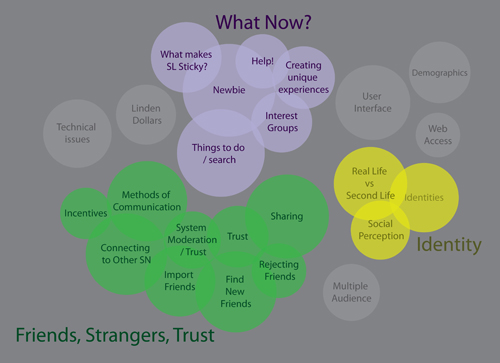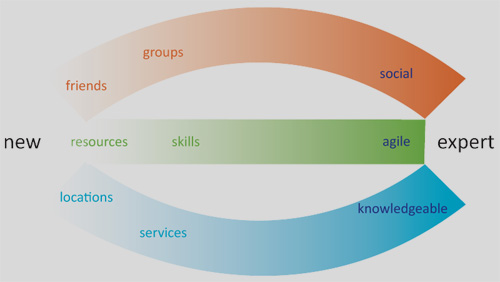In the research phase, we have conducted background research to understand the industry of virtual worlds and social networks, and we have also conducted user research to understand user needs and current user experiences. In the following sections, our findings are explained within the context of our foci, illuminating the areas that merit improvement and fall within our scope.

What do I do now?
Being lost in the complexities of Second Life is a problem shared amongst all users. New users often have no idea what they can do in Second Life or where to find it, and this problem is compounded with the difficulties with the user interface. The confusions has spread to the more seasoned Residents as well; these Residents feel that Second Life has grown past their ability to navigate easily.
While experienced users have migrated away from the Search feature to rely more heavily on their groups and friends, new residents often have neither, and rely heavily on the search feature. However, the search feature confused new users because of the complex interface; it is also distrusted by experienced users because rankings can be easily manipulated. This issue of trust extends to our next focus.
How do I socialize with people in virtual communities?
The first obstacle to overcome when socializing with new people is the issue of trust. We discovered that Residents make judgment calls based on subtle cues such as demeanor and more overt cues such as actions. We also know that new users like to consider mutual connections between themselves and the other person. However, mutual connections are not available at first to most users, so some other system must be in place to allow them to feel more comfortable with their assessments of other Residents.
Second Life relationships are built through collaboration, and receiving help not only deepens the user's trust in the helper, but also increases the user's enjoyment of Second Life. New users do not participate in collaborative activities such as building objects or attending events, and the best way to encourage collaboration is by placing them in a social situation that is conducive to such activities. While real life connections give users compelling reasons to be in Second Life, a gathering of like minded individuals can give equal motivation to remain in-world.
How do I shape my identity/identities in virtual communities?
A Resident's identity is central not only to their experience of Second Life, but in how other Residents experience the Residents. New residents are interested in editing their appearance, and this idea of the face you put forward can be continued to an avatar's activities and interests. We have seen that it is a Resident's mannerisms and actions upon which they are judged.
The profile is another way to determine what a Resident is about. Within these profiles we see friends, favorite places, hobbies, and even a personal website. But we often do not see real life names or e-mails. This distinction allows many users to develop their avatar into who they want to be in Second Life, and protecting this freedom of expression is paramount. A Resident's anonymous real life identity by no means indicates social behavior and sharing is not prevalent in Second Life. We, as Residents, have experienced the willingness of other Residents to share favorite locations and activities. This openness and sharing of users' experiences and not necessarily their identities supports an object-centric social network that shares the artifacts of Residents' second lives.
Concluding Remarks

Throughout this research we have seen a recurring pattern: A need of new users and a paired offering of the community. New users come into Second Life alone, awkward, and lost. They have great difficulty not only with the interface but in utilizing the many ways to participate in the world around them. They fail to grasp what is available in this rich community and are handicapped in their explorations
Second Life has all of the missing pieces to the new user's puzzlement. Rich communities and Resident-made forums embrace and help with any aspect of Second Life imaginable. Residents have created a dazzling array of activities, locations, accessories and animations. All the pieces of a grand Second Life are within the world waiting to be discovered, but new users repeatedly fail to find them. Those Residents who do not make it past their tenth log in never see the breadth of the community and all it has to offer. This very connection, this bridge to the community and indeed a whole world needs to be brought to new users.